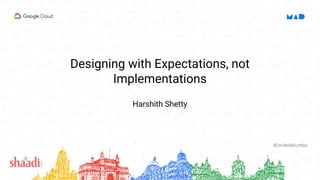TDD - Designing with Expectations, not Implementations
•
0 gefällt mir•251 views
TDD approach made simple based on the experience and journey gone through learning and implementing it in a large scale android app, i.e. Shaadi.com.
Melden
Teilen
Melden
Teilen
Downloaden Sie, um offline zu lesen

Empfohlen
Weitere ähnliche Inhalte
Was ist angesagt?
Was ist angesagt? (20)
Giving automated tests the love they deserve at Listings

Giving automated tests the love they deserve at Listings
Mixing testing types to improve your testing results

Mixing testing types to improve your testing results
Quality assurance in the early stages of the product

Quality assurance in the early stages of the product
Ähnlich wie TDD - Designing with Expectations, not Implementations
Ähnlich wie TDD - Designing with Expectations, not Implementations (20)
VT.NET 20160411: An Intro to Test Driven Development (TDD)

VT.NET 20160411: An Intro to Test Driven Development (TDD)
TDD and Simple Design Workshop - Session 1 - March 2019

TDD and Simple Design Workshop - Session 1 - March 2019
An insight to test driven development and unit testing

An insight to test driven development and unit testing
Kürzlich hochgeladen
Vip Call Girls Noida ➡️ Delhi ➡️ 9999965857 No Advance 24HRS Live

Vip Call Girls Noida ➡️ Delhi ➡️ 9999965857 No Advance 24HRS LiveCall Girls In Delhi Whatsup 9873940964 Enjoy Unlimited Pleasure
Reassessing the Bedrock of Clinical Function Models: An Examination of Large ...

Reassessing the Bedrock of Clinical Function Models: An Examination of Large ...harshavardhanraghave
Steps To Getting Up And Running Quickly With MyTimeClock Employee Scheduling ...

Steps To Getting Up And Running Quickly With MyTimeClock Employee Scheduling ...MyIntelliSource, Inc.
CHEAP Call Girls in Pushp Vihar (-DELHI )🔝 9953056974🔝(=)/CALL GIRLS SERVICE

CHEAP Call Girls in Pushp Vihar (-DELHI )🔝 9953056974🔝(=)/CALL GIRLS SERVICE9953056974 Low Rate Call Girls In Saket, Delhi NCR
Kürzlich hochgeladen (20)
A Secure and Reliable Document Management System is Essential.docx

A Secure and Reliable Document Management System is Essential.docx
Learn the Fundamentals of XCUITest Framework_ A Beginner's Guide.pdf

Learn the Fundamentals of XCUITest Framework_ A Beginner's Guide.pdf
Unveiling the Tech Salsa of LAMs with Janus in Real-Time Applications

Unveiling the Tech Salsa of LAMs with Janus in Real-Time Applications
Optimizing AI for immediate response in Smart CCTV

Optimizing AI for immediate response in Smart CCTV
Tech Tuesday-Harness the Power of Effective Resource Planning with OnePlan’s ...

Tech Tuesday-Harness the Power of Effective Resource Planning with OnePlan’s ...
Short Story: Unveiling the Reasoning Abilities of Large Language Models by Ke...

Short Story: Unveiling the Reasoning Abilities of Large Language Models by Ke...
Shapes for Sharing between Graph Data Spaces - and Epistemic Querying of RDF-...

Shapes for Sharing between Graph Data Spaces - and Epistemic Querying of RDF-...
W01_panagenda_Navigating-the-Future-with-The-Hitchhikers-Guide-to-Notes-and-D...

W01_panagenda_Navigating-the-Future-with-The-Hitchhikers-Guide-to-Notes-and-D...
CALL ON ➥8923113531 🔝Call Girls Badshah Nagar Lucknow best Female service

CALL ON ➥8923113531 🔝Call Girls Badshah Nagar Lucknow best Female service
Vip Call Girls Noida ➡️ Delhi ➡️ 9999965857 No Advance 24HRS Live

Vip Call Girls Noida ➡️ Delhi ➡️ 9999965857 No Advance 24HRS Live
Reassessing the Bedrock of Clinical Function Models: An Examination of Large ...

Reassessing the Bedrock of Clinical Function Models: An Examination of Large ...
CALL ON ➥8923113531 🔝Call Girls Kakori Lucknow best sexual service Online ☂️

CALL ON ➥8923113531 🔝Call Girls Kakori Lucknow best sexual service Online ☂️
The Real-World Challenges of Medical Device Cybersecurity- Mitigating Vulnera...

The Real-World Challenges of Medical Device Cybersecurity- Mitigating Vulnera...
Unlocking the Future of AI Agents with Large Language Models

Unlocking the Future of AI Agents with Large Language Models
Steps To Getting Up And Running Quickly With MyTimeClock Employee Scheduling ...

Steps To Getting Up And Running Quickly With MyTimeClock Employee Scheduling ...
The Ultimate Test Automation Guide_ Best Practices and Tips.pdf

The Ultimate Test Automation Guide_ Best Practices and Tips.pdf
CHEAP Call Girls in Pushp Vihar (-DELHI )🔝 9953056974🔝(=)/CALL GIRLS SERVICE

CHEAP Call Girls in Pushp Vihar (-DELHI )🔝 9953056974🔝(=)/CALL GIRLS SERVICE
TDD - Designing with Expectations, not Implementations
- 1. Designing with Expectations, not Implementations Harshith Shetty
- 2. Test ● When to write tests? ● Does your test run fast?
- 3. Why TDD?
- 4. ● Ask ● Describe ● Fulfill ● Move on Approach
- 5. Ask (what it’ll do) ● Expectations from the feature ● Clarity ● Documentation
- 6. Describe (how it’ll do) ● Interfaces of the feature ● Relationship between objects ● Flow of the feature ● Knowing when it’s done
- 7. Some Mocks:
- 8. Examples:
- 9. Fulfill (make it do) ● Implementation of feature ● Decoupled code ● Separation of business Logic from platform ● Faster feedback
- 12. Move on ● Regression tests
- 13. Real life scenario 3 buttons x 7 states x 3 user types x 2 experiments = 126 cases
- 17. 3 Laws of TDD ● You must write a failing test before you write any production code. - Robert C. Martin (Uncle Bob) ● You must not write more of a test than is sufficient to fail, or fail to compile. ● You must not write more production code than is sufficient to make the currently failing test pass.
- 18. Benefits ● Documented code ● Better code reviews ● Rewarding ● Refactor with Confidence ● Faster development cycles ● Less Debugging
- 19. Notes ● Always test the interfaces, Requirements are stable, implementations are not. ● Follow a clean architecture. ● Practice. Practice. Practice. Make it a habit. ● Split the code, if tests become more. ● If not for product, do it for you. ● If not for you, do it for the next developer.
- 20. Examples:
- 21. Examples:
- 22. Examples:
- 24. ● “Ruby Midwest 2011 - Keynote: Architecture the Lost Years by Robert Martin” https://www.youtube.com/watch?v=WpkDN78P884 ● “The Three Laws of TDD (Featuring Kotlin)” https://www.youtube.com/watch?v=qkblc5WRn-U ● Growing Object-Oriented Software: Guided By Tests by Steve Freeman References